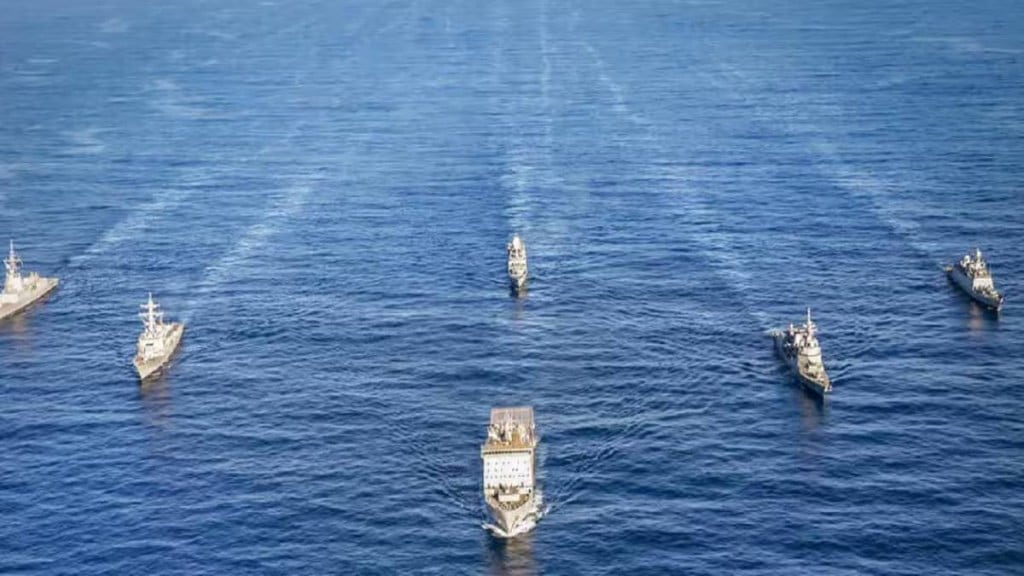Huma Siddiqui
New Delhi, Jan 9
The Indian Navy is boosting patrols in the Arabian Sea to counter rising piracy and drone threats. More than 10 warships have been deployed in response to increased dangers in the Gulf of Aden.
Initially, six warships were dispatched, but the number was raised to ten due to escalating risks.
Why?
According to sources, “The navy closely monitors the situation in the Arabian Sea and the Gulf of Aden. With a surge in attacks on merchant vessels and drone strikes, the decision to deploy more warships aims to enhance security and safeguard against potential threats in these vital maritime regions.”
How many more?
Without specifying the numbers, according to sources, more warships are expected to move in that region as the tensions are escalating.
India is actively conducting maritime security operations independently to proactively stabilize the situation and enhance overall maritime security in the region. In contrast to the US-led Operation Prosperity Guardian in the Red Sea, India opted out due to attacks by Houthi rebels. Consequently, the naval presence in the Arabian Sea has doubled in the past ten days, with 10 warships currently patrolling the high seas, up from two in early December.
Financial Express Online has reported previously that each vessel in the fleet is equipped with helicopters and satellite connectivity to the naval operations room, fortified with specialized equipment. These warships, alongside marine commandos, have the capability to both launch and counter potential attacks. Surveillance planes like Boeing P8I and Predator drones MQ-9B Sea Guardians leased from the US based General Atomics conduct continuous aerial monitoring as part of the maritime security strategy.
The warships’ assigned task includes vigilant monitoring of mid-sea areas for rogue ships, given recent attacks farther from the coast. Over the past two weeks, the Navy has boarded and searched dozens of suspicious vessels. Stealth warships deployed include INS Kolkata, INS Kochi, INS Chennai, INS Mormugao, INS Talwar, and INS Tarkash, working in coordination with the Indian Coast Guard to intensify surveillance efforts over the Exclusive Economic Zone.
On January 5th, INS Chennai, accompanied by MARCOS commandos, successfully thwarted the attempted hijacking of MV Lila Norfolk in the Arabian Sea, rescuing the 21-member crew. The incident on December 23rd involving MV Chem Pluto, hit approximately 400 km west of the Indian coast, reignited concerns about rogue ships launching missiles. The United States attributed the attack to Iran, accusing them of launching a “self-destructing” drone, but the Iranian Foreign Ministry dismissed it as a “worthless accusation.”
The Indian Navy’s statement underlines ‘mission-based deployments,’ facilitating swift responses to evolving security challenges. Since October 2008, India has consistently deployed warships for anti-piracy patrols in the Gulf of Aden, showcasing its commitment to maritime security.
Meanwhile …
On January 4, two ships transporting a significant amount of oil to areas controlled by Israel faced attacks in the Indian Ocean. As reported by Lebanon-based TV channel Al Mayadeen, an undisclosed source provided this information.
The initial vessel, the (CHEM CILICON), affiliated with the Israeli ACE company and sailing under Liberia’s flag, was targeted northwest of the Maldives Islands. The second tanker, (PACIFIC GOLD), owned by the Stern Company and linked to Israel, encountered an attack near Cochin Port in India.
These incidents mark concerns about developments in the region’s maritime activities, raising questions about security measures and geopolitical tensions.

